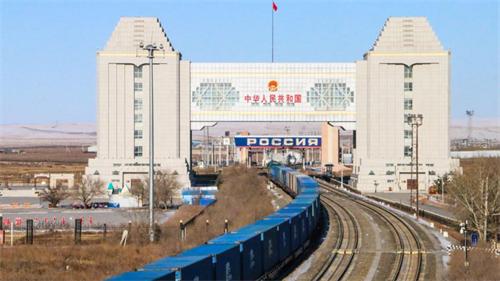Russia-China Trade Corridor: Sanctions-Proof Commerce Grows

Since the full-scale outbreak of the Russia-Ukraine conflict in 2022, Western sanctions against Russia have cascaded like a row of dominoes. From financial “decoupling” to sweeping embargoes in energy, trade, and technology, an unprecedented web of pressure has been constructed. Russia was expelled from the SWIFT global settlement system, its major banks frozen, key energy pipelines cut off, and foreign companies withdrew en masse—as if the country had been severed from the global economic mainstream overnight.
However, contrary to many observers’ expectations, Russia’s economy has not collapsed under this intense pressure. Instead, Russia has maintained stability through energy and food self-sufficiency and rapidly shifted its diplomatic and economic focus eastward—particularly toward comprehensive trade cooperation with China, which has become a crucial pillar for resisting isolation and rebuilding growth.
Rebuilding and Reinforcing Sino-Russian Economic Ties
China and Russia are natural economic partners—geographically adjacent and economically complementary in resources and industrial structure. Since the outbreak of the war, this relationship has not only remained intact but has grown even closer amid geopolitical rifts. China has become Russia’s new major buyer of energy exports, while also supplying essential goods such as industrial products, auto parts, consumer electronics, and daily necessities. In 2024, trade between China and Russia hit a new high of $244.8 billion, marking a 1.9% increase compared to the previous year. China continued to hold its position as Russia’s top trading partner for the 15th year in a row.
Why has Sino-Russian trade grown against the tide of global sanctions? The reasons lie not only in mutual political trust and economic complementarity but also in the emergence of physical and institutional infrastructure for a “trade corridor.”
Land and Sea Routes: The Real Arteries of the Corridor
As traditional westbound trade routes became blocked, alternative corridors between Russia and China quickly developed. Rail lines such as the China-Europe Express and the “China–Central Asia–Russia” route—via Kazakhstan, Mongolia, and other third countries—enable efficient connections. These routes now carry not only traditional industrial goods but also high-value-added products like new energy vehicles and photovoltaic components. Transit time remains stable at 14–16 days, significantly improving cross-border trade efficiency.
At the same time, Russia has been stepping up efforts to expand and modernize its ports in the Far East. The “Primorye-1” and “Primorye-2” corridors have boosted the Trans-Siberian Railway’s annual capacity to 80 million tons. New electronic logistics systems allow real-time data sharing between Chinese and Russian customs authorities. Border crossing efficiency has soared, with daily customs clearance increasing from 300 to 1,000 trucks. Key infrastructure links like the Heihe–Blagoveshchensk road bridge and the Tongjiang–Nizhneleninskoye railway bridge are steadily entering service, overcoming severe climatic conditions and strengthening transport connectivity between China’s Northeast and Russia’s Far East.
These multimodal transport systems not only improve the logistical “lifelines” between China and Russia, but also extend China’s Belt and Road Initiative deeper into Northeast Asia, driving industrial integration in surrounding regions.
Institutional Cooperation Upgrade: A New “Greater Tumen” Experiment
Institutional innovation is progressing in parallel. In May 2025, a China-Russia Joint Declaration announced deeper collaboration across eight areas: trade, investment, finance, energy, infrastructure, and more. The “Greater Tumen Initiative” is being upgraded into a fully legal international organization. For the first time, cross-border cooperation among China, Russia, North Korea, South Korea, and Mongolia will have legal enforcement, efficient decision-making mechanisms, and a dispute resolution system. This provides long-term stability for regional energy networks, digital economy, and logistics collaboration.
This marks a shift from consensus-based cooperation to rules-based integration—indicating that Sino-Russian economic ties are evolving from trade links to regional rule-making frameworks.
Russia’s “Bulletproof Vest”: Self-Reliance and De-dollarization
Russia’s ability to withstand sanctions pressure also stems from two “bulletproof vests”: strategic self-sufficiency in energy and food, and a move away from the U.S. dollar. Russia’s agricultural self-sufficiency rate exceeds 155%, and it remains the world’s largest wheat exporter. On the financial front, Russia has established alternatives to Western systems by promoting its domestic Mir payment network and implementing the SPFS clearing mechanism to reduce dependence on SWIFT.
In recent years, trade settlement in Chinese yuan has surged between Russia and countries like China, Iran, and India. In 2023, Russia’s foreign trade settlements in yuan increased by 47% year-on-year, while the share of the U.S. dollar in Russia’s external settlements plummeted from 80% to under 10%. De-dollarization is no longer just a slogan—it is becoming an operational reality.
Opportunities and Risks in Tandem
On the surface, Sino-Russian economic cooperation appears to be thriving—from sustained trade growth to accelerated logistics, revived cultural exchanges, and institutional cooperation. Yet, despite these advancements, significant challenges and potential risks remain beneath the surface.
First, both China and Russia continue to face strong pressure and strategic constraints from Western countries. The U.S. continues to tighten export restrictions in high-tech sectors, aiming to disrupt key nodes in the Sino-Russian cooperation chain. Second, while de-dollarization is underway, creating a fully alternative settlement system in the short term remains difficult. Although the yuan is gaining favor in Russia, its global acceptability and liquidity are still limited. Displacing the dollar’s dominance will take time.
More critically, the high interdependence between China and Russia means that disruptions in any logistics hub, energy pipeline, or cross-border financial network could trigger cascading effects.
From the Periphery to the Center?
The gradual expansion of the Russia-China trade corridor represents a “resilience strategy” amid dramatic geopolitical shifts. It is not a rejection of globalization, but a pragmatic response to its fragmentation. Whether this high-level cooperation can continue depends on both countries’ ability to advance mutual trust, technological autonomy, institutional development, and risk management in tandem.
As the West remains fixated on a logic of sanctions, China and Russia may be forging a steadier path—exploring a new paradigm of global cooperation immune to external coercion.



